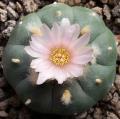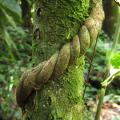
DMT-Nexus member
Posts: 212 Joined: 16-Oct-2016 Last visit: 15-Jun-2023
|
Dear Nexians, I recently sent a harmine (HAR) sample to EC for analysis that could learn us something on the long-term stability of harmala's. In fact, I already sent a sample of this HAR-batch 3 years ago (see post #332 in this thread). It came out as being 78% HAR / 4% DHH (harmaline). It has been stored as a freebase, most of the time in the freezer. Now, 3 years later the results of EC say: 81% HAR / 0,5% DHH. If you read TIHKAL entry #13(harmine) pp.452-453, Shulgin also struggled with the question why his batch of pure DHH appeared to have changed in a mixture of DHH and HAR. In his 3th hypothesis, he refers to the same findings in botanical samples that were stored and appeared tot only contain HAR after many years. So this EC-analysis could be a confirmation of this hypothesis, namely that over time, DHH spontaneously transforms to HAR by losing a hydrogen-atom. Still a question remains. My sample was only three years old and already most (88%) of the DHH was converted to HAR, even in a freezing environment. That seems very quick, for the sample of Shulgin seemed to have taken many many years to convert from +/-100% to 70% purity. Why should my sample degrade that fast? Anyways, thanks to Endlessness for providing the opportunity for analysis, check out the "free test for nexus members" -thread.  Does anyone else have experience with long-term storage and analysis of harmala's? Good journeys, An1cca
|
|
|
|
|

DMT-Nexus member

Posts: 14191 Joined: 19-Feb-2008 Last visit: 24-Apr-2024 Location: Jungle
|
Interesting stuff, thanks for doing this experiment  I suppose your sample was in freebase? Maybe some salt form would be more stable? Some time ago I tested some commercially available dried botanical samples that were very low in both THH and DHH. I have not tested a fresh or near-fresh botanical sample yet, would be interesting to compare some. Will talk to a friend who's growing or maybe we can get a Nexian who grows caapi to help with this experiment, send a fresh sample vs month old vs year old vs multiple years old, or something.
|
|
|

DMT-Nexus member
Posts: 212 Joined: 16-Oct-2016 Last visit: 15-Jun-2023
|
The batch was stored as freebase, but for analysis, I converted the sample to salt form using Manske so that it would better survive transport. Possibly, this conversion might have skewed the ratio HAR/DHH. I don't think Manske selectively precipitates the harmala's, but to be sure I could send a freebase sample as well?
|
|
|

DMT-Nexus member
Posts: 4031 Joined: 28-Jun-2012 Last visit: 05-Mar-2024
|
Hi An1cca, nice to see you. I'm very curious how the crystals look like comparing 3 years back and now, if possible. Also interesting is the difference between pre and post this mentioned manske (both in FB). I've old DHH in FB and could do such experiment on my end. Would be interesting to see confirmation between crystal form and EC results. You might remember my post THH > DHH... does it convert back?I've read someone suggesting that THH would be fairly unstabe. So on a visual clue THH stayed stable, and my DHH taste test till today is still more bitter (maybe less bitter than years back? Hard to remember) than my harmine. I realize crystal shape test is no EC. But would be nice to see how they relate. Do you have some of that un-mansked DHH to compare with the mansked DHH (and rolled back to FB)? Taste difference? Crystal difference? Sorry I'm curious  Respectful greetings, Jees
|
|
|

DMT-Nexus member
Posts: 4031 Joined: 28-Jun-2012 Last visit: 05-Mar-2024
|
PS: sorry I've failed so far my announced thread about attempts microscope checking optimization, but I can already say I do not work with ammonia any more for in situ crystallization but lye at 1mol.  Also to think of the fact we do manskes all the time on syrian rue where tons of harmaline survives easily...
|
|
|

DMT-Nexus member
Posts: 1111 Joined: 18-Feb-2017 Last visit: 02-Apr-2024
|
An1cca wrote:It came out as being 78% HAR / 4% DHH (harmaline). It has been stored as a freebase, most of the time in the freezer. Now, 3 years later the results of EC say: 81% HAR / 0,5% DHH.
[..]
Still a question remains. My sample was only three years old and already most (88%) of the DHH was converted to HAR, even in a freezing environment. 88% sounds like a lot, but then, with such small relative DHH content 4% -> 0.5%, it's easy to introduce an error, especially when it involves conversion from FB to salt. I don't know about Manske being selective, but could it give harmine a higher 'priority' in precipitating than DHH? Which, in turn, would make a difference in cases where the DHH content is relatively low? But yes, it was stored as FB, which is less stable. I'd imagine the salt to be much more stable. An1cca wrote:So this EC-analysis could be a confirmation of this hypothesis, namely that over time, DHH spontaneously transforms to HAR by losing a hydrogen-atom. Actually it's two hydrogen atoms.
|
|
|

DMT-Nexus member
Posts: 212 Joined: 16-Oct-2016 Last visit: 15-Jun-2023
|
Jagube wrote:
Actually it's two hydrogen atoms.
Completely correct of course, Jagube. Actually, I blindly quoted Shulgin here... I think I will send a FB sample as well and do some microscopy on both. I'll keep you guys posted!
|
|
|

Boundary condition
 
Posts: 8617 Joined: 30-Aug-2008 Last visit: 16-Apr-2024 Location: square root of minus one
|
Quote:Actually it's two hydrogen atoms. In total. Probably one of them goes before the other one, even if only briefly before. And another question would be, do the atoms depart as first a proton, followed by a hydride anion, as would be the case if the reaction is somehow base-catalysed? Or are they being abstracted as radicals if, perhaps, molecular oxygen is involved? “There is a way of manipulating matter and energy so as to produce what modern scientists call 'a field of force'. The field acts on the observer and puts him in a privileged position vis-à-vis the universe. From this position he has access to the realities which are ordinarily hidden from us by time and space, matter and energy. This is what we call the Great Work." ― Jacques Bergier, quoting Fulcanelli
|
|
|

DMT-Nexus member
Posts: 1045 Joined: 12-Mar-2010 Last visit: 12-Apr-2024 Location: Urf
|
Is there any reason not to believe that DHH (harmaline) would stay more stable while in the seed (Syrian Rue)? Or even in a powdered, unextracted (but airtight) form? From the unspoken
Grows the once broken
|
|
|
DMT-Nexus member
Posts: 183 Joined: 10-Jun-2017 Last visit: 13-Jul-2020
|
downwardsfromzero wrote:Quote:Actually it's two hydrogen atoms. In total. Probably one of them goes before the other one, even if only briefly before. And another question would be, do the atoms depart as first a proton, followed by a hydride anion, as would be the case if the reaction is somehow base-catalysed? Or are they being abstracted as radicals if, perhaps, molecular oxygen is involved? Yes, that would be my guess. Oxidation by O2, via radical formation. It wouldn't be surprising to discover the reaction proceeds easily, given the product is further conjugated compared to the starting material. This is speculation of course. The other thing to consider is that storage may not have led to degradation, but rather manipulation does. Op has described 2 opportunities for this. Conversion from freebase to salt. Then the sample was probably converting back to freebase, before analysis. Not to mention that sometimes reactions proceed in the injection port (especially in gcms), or on the column. Although I'm guessing hplc was used rather than gcms.
|
|
|

DMT-Nexus member

Posts: 14191 Joined: 19-Feb-2008 Last visit: 24-Apr-2024 Location: Jungle
|
Interesting discussion  Yeah it was HPLC-MS
|
|
|

Kalt und Heiß, Schwarz und Rot, Kürper und Geist, Liebe und Chaos
 
Posts: 4661 Joined: 02-Jun-2008 Last visit: 30-Apr-2022
|
leratiomyces wrote:downwardsfromzero wrote:Quote:Actually it's two hydrogen atoms. In total. Probably one of them goes before the other one, even if only briefly before. And another question would be, do the atoms depart as first a proton, followed by a hydride anion, as would be the case if the reaction is somehow base-catalysed? Or are they being abstracted as radicals if, perhaps, molecular oxygen is involved? Yes, that would be my guess. Oxidation by O2, via radical formation. It wouldn't be surprising to discover the reaction proceeds easily, given the product is further conjugated compared to the starting material. This is speculation of course. The other thing to consider is that storage may not have led to degradation, but rather manipulation does. Op has described 2 opportunities for this. Conversion from freebase to salt. Then the sample was probably converting back to freebase, before analysis. Not to mention that sometimes reactions proceed in the injection port (especially in gcms), or on the column. Although I'm guessing hplc was used rather than gcms. Yup, seems to me too a case of oxidation of DHH to harmine or maybe something else? I have some syrian rue extract as freebase in my freezer, it's been sitting there for 8 years. When I recently tried to dissolve some of it (~100 mg) in vinegar not all of it dissolved and some chunks just remained undissolved no matter the vinegar volume or pH. The extract was produced after multiple meticulus filtrations and I doubt that any plant matter made it to the extract. I am more inclined to think that over time some other degradation products may appear. Maybe worth analysing? Need to calculate between salts and freebases? Click here! Need to calculate freebase or salt percentage at a given pH? Click here!
|
|
|

DMT-Nexus member
Posts: 4031 Joined: 28-Jun-2012 Last visit: 05-Mar-2024
|
Took a peak at my 3 year old DHH, stored as FB in a dry dark drawer and now recrystallized for inspection. Taste is bitter = DHH sign. An1cca I think you agree that this very DHH dominant, a 50% mix of DHH/harmine looks completely different. The 1/4 rd left side of the pic is clearly less DHH-feather and things get more spiky than we would expect from DHH, this could be some work of harmine typical stick-type interference. I lean that in fresh DHH these stick-signatures do not appear easily, some DHH could have gone back to harmine indeed. The whole drop gets inspected, the pic is just a sample. As we speak this batch is now crystallizing in a manske to take a pic again after the manske. An1cca we did differ in storage, mine was at room temp, yours got friezed IIRC. Jees attached the following image(s):  DHH.3yearsOld.FBstored.jpg (306kb) downloaded 157 time(s).
|
|
|

DMT-Nexus member
Posts: 212 Joined: 16-Oct-2016 Last visit: 15-Jun-2023
|
Interesting Jees! I agree that the picture looks very DHH-like, although the ferns are quite 'longitudinal'. I might do just the same procedure on my batch as soon as I get my microscope back.
By the way, why are you using NaOH now in stead of NH4OH for microscopy in situ?
|
|
|

DMT-Nexus member
Posts: 212 Joined: 16-Oct-2016 Last visit: 15-Jun-2023
|
Also, when sending the sample in the OP, I was hoping that somehow the first analysis got it wrong and that the sample would be purer than 78%. Because really, even after all the Manskes I have done on this sample, the purity doesn't seem to increase any further. What is this remaining 20%? On microscopy, it seems to hide itself. Also, after conversion to THH, this 20% seemed to have disappeared altogether (post #332 in VDS-thread, sample 7)? What I haven't tried is to recrystallise the sample to get rid of this extra. Would ethanol work for this?
And another mystery: if we follow VDS's protocols strictly, why do his samples have narrow and lierature-matching melting points? Surely samples that are only 80% pure can't give these results?
Jees, in the VDS-thread under post #342 there are some pictures of the different samples I sent back then. Your sample seems to resemble #6: 74% DHH, 8% HAR.
|
|
|

DMT-Nexus member
Posts: 1111 Joined: 18-Feb-2017 Last visit: 02-Apr-2024
|
Jees wrote:Took a peak at my 3 year old DHH, stored as FB in a dry dark drawer and now recrystallized for inspection. Taste is bitter = DHH sign. The bitter taste will come through even with very little DHH present. If your 3 year old DHH had converted 95% to harmine, it would still be bitter.
|
|
|

DMT-Nexus member
Posts: 4031 Joined: 28-Jun-2012 Last visit: 05-Mar-2024
|
Jagube wrote:Jees wrote:Took a peak at my 3 year old DHH, stored as FB in a dry dark drawer and now recrystallized for inspection. Taste is bitter = DHH sign. The bitter taste will come through even with very little DHH present. If your 3 year old DHH had converted 95% to harmine, it would still be bitter. You might have a point there. This would mean my harmine and THH was fairly DHH free being utterly tasteless. An1cca wrote: the picture looks very DHH-like, although the ferns are quite 'longitudinal'... Your sample seems to resemble #6: 74% DHH, 8% HAR. Yes here and there the lancet tendency is concurring the feathering, there is this affection. I would not be surprised if my picture is in the 75% DHH range. Question still remains why yours almost fully rolled back to harmine. I've little trust that manske does that, we'll see. Gonna freeze/thaw some to see if that changes things. An1cca wrote:By the way, why are you using NaOH now in stead of NH4OH for microscopy in situ? Will keep it short and essential inhere to prevent thread size exploding like the VDS one  1 drop of 1mol lye on the glass + smear open a bit into a thin film. Lye keeps the base-power up in such a thin film while ammonia evaps and looses base stability/ability gradually. On that lye film put 1 drop of salted alkaloids, when this drop's concentration is optimal (creating a semi-translucent 'milk' ) there is a nice chemical balance slowly taking the alkaloids into freebase. Notice I've reversed base and acid drops on the glass, I just got more of a dependable picture result doing that way. The thin film helps with the narrow depth of field of the microscope. In a bulging drop there will be a lot more crystals out of focus. PS: working with a 100euro microscope, nothing too fancy. Using an adapter to mount camera in the eye-piece. Use the back LCD of camera as a monitor, is more luxurious than peeking with one eye in an eye piece. Post processed the uploaded picture with software to bump contrasts and clearness.
|
|
|

DMT-Nexus member
Posts: 212 Joined: 16-Oct-2016 Last visit: 15-Jun-2023
|
Thanks a lot for these practical insights, Jees. I'll gladly change my outdated habits 
|
|
|

DMT-Nexus member
Posts: 1045 Joined: 12-Mar-2010 Last visit: 12-Apr-2024 Location: Urf
|
Will no one answer my question about harmaline stability within the seed? From the unspoken
Grows the once broken
|
|
|

DMT-Nexus member

Posts: 14191 Joined: 19-Feb-2008 Last visit: 24-Apr-2024 Location: Jungle
|
RhythmSpring wrote:Will no one answer my question about harmaline stability within the seed? I don't have any data comparing same batch before and after storage to back up my opinion but considering some long term stored syrian rue seeds had significant amount of harmaline, I'd say indeed in the natural salt form (at least with rue) harmaline seems stable
|